The Elusive 120 degree parhelion - OPOD
The Elusive 120 Degree Parhelion: Exploring a Rare Atmospheric Phenomenon
Have you ever witnessed a mesmerizing optical illusion in the sky known as the 120° parhelion? This elusive phenomenon, often overlooked amidst the beauty of the natural world, captivates those lucky enough to spot it. In this article, we will delve deeper into the intricacies of the 120° parhelion, shedding light on its formation, characteristics, and how to identify it.
The Enigmatic Appearance
The 120° parhelion, also referred to as the "phantom sundog," manifests as a white spot located approximately 120 degrees from the sun. This optical marvel can be quite challenging to discern, especially when set against a backdrop of patchy clouds. Its fleeting nature further adds to its mystique, as its visibility fluctuates over a span of mere minutes.
To correctly identify a suspicious white spot as a 120° parhelion, ensure that it is precisely 120 degrees away from the sun and at the same altitude. Surprisingly, this captivating atmospheric phenomenon may grace the sky more frequently than initially believed, evoking a sense of wonder and awe in those who manage to catch a glimpse.
Unveiling the Science Behind the 120° Parhelion
The formation of the 120° parhelion shares similarities with its counterpart, the 22° parhelion or sundog. Both are attributed to horizontally aligned plate crystals. However, for the elusive 120° parhelion to materialize, thicker crystals or those with alternate sides of varying lengths (triangular aspect) are ideal.
Unlike other atmospheric optical phenomena, such as rainbows or halos, the 120° parhelion lacks vibrant colors. This absence of color is due to the entry and exit angles of light being identical, resulting in zero net color dispersion. Instead, the 120° parhelion presents itself as a striking white spot against the canvas of the sky.
Visualizing the 120° Parhelion
To better comprehend the visual appearance of the 120° parhelion, let us explore some images captured by Hans Stocker in Haarlem, The Netherlands. In one image, the 120° parhelion is situated at the upper left of the parhelic circle, while the sun is positioned at the lower right, encircled by a 22° halo with an upper tangent arc at its peak.
However, broken clouds can obstruct the parhelic circle, making it challenging to definitively identify a 120° parhelion in such conditions. Yet, even in these instances, the phenomenon may still be present, waiting to reveal itself when the atmospheric conditions align perfectly.
Unraveling the Mysteries: Fading and Transition
In another captivating image captured by Stocker, we witness a characteristic fading of the parhelic circle beyond the 120° parhelion. This fading occurs due to a transition from total internal reflection, a process responsible for creating various atmospheric optical phenomena.
As we continue to unravel the mysteries surrounding the 120° parhelion, it is crucial to note that this article has been automatically converted from its original form. While our goal is to provide a comprehensive exploration of this fascinating phenomenon, we encourage you to refer to the original article for a more accurate representation.
In conclusion, the elusive 120° parhelion offers a glimpse into the intricate beauty of atmospheric optics. Its ethereal nature and infrequent appearances make it a true gem for those fortunate enough to observe it. By understanding its formation, characteristics, and visual cues, we can further appreciate the wonders that unfold in the vast expanse above us. So, keep your eyes to the sky and remain open to the possibility of encountering the enigmatic 120° parhelion.
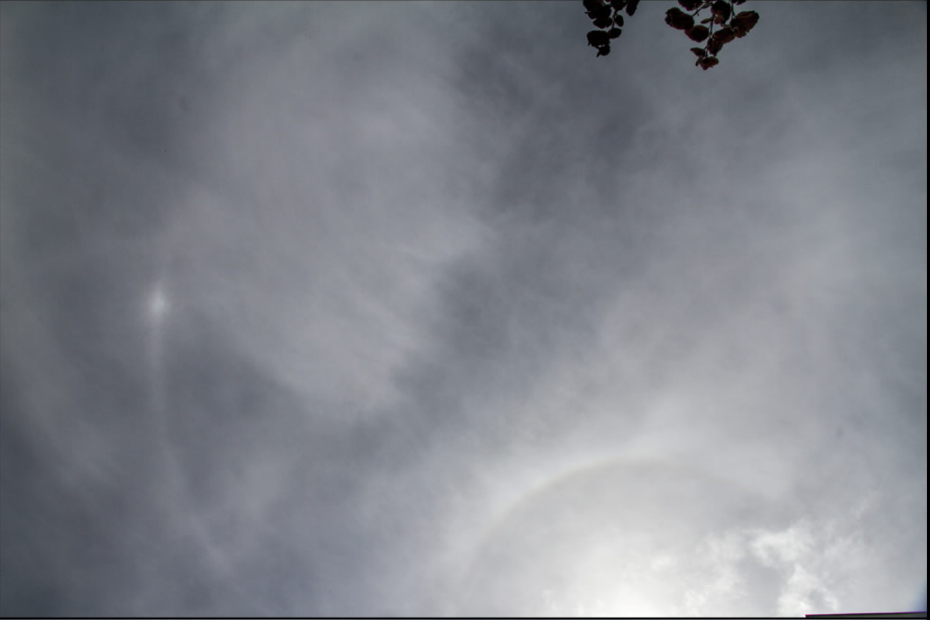
The Elusive 120° Parhelion
Hans Stocker captured these scenes at Haarlem in The Netherlands. The 120� parhelion is at upper left on the parhelic circle. The sun at lower right is surrounded by a 22� halo with an upper tangent arc at its top.
The 120P is white and can be difficult to distinguish from a cloudy background especially when the clouds are patchy. Hans' parhelion lasted for just a few minutes and in that time its visibility waxed and waned.
Be sure that a suspicious white spot is 120� from the sun and at the same altitude. It is probably present in the sky more often than thought.
Images ©Hans Stocker, shown with permission
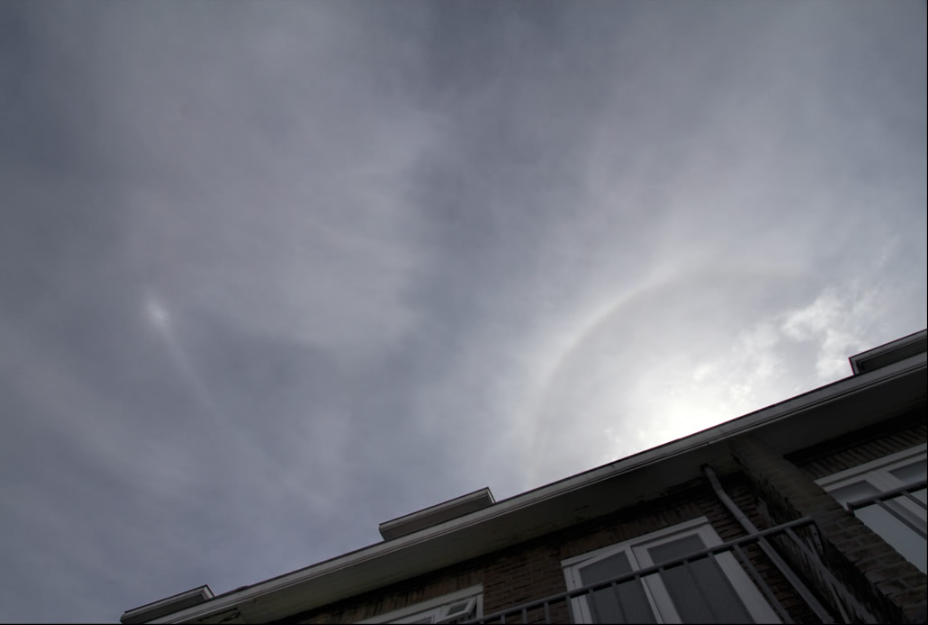
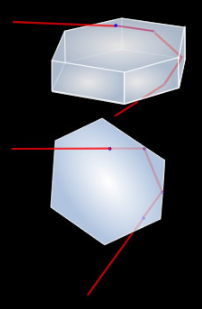
Like the 22° parhelion or sundog, horizontal aligned plate crystals are responsible.
Thick crystals or ones with alternate sides long and short sides (triangular aspect) are best.
There are no colours because the entry and exit angles are the same and the net colour dispersion is zero.
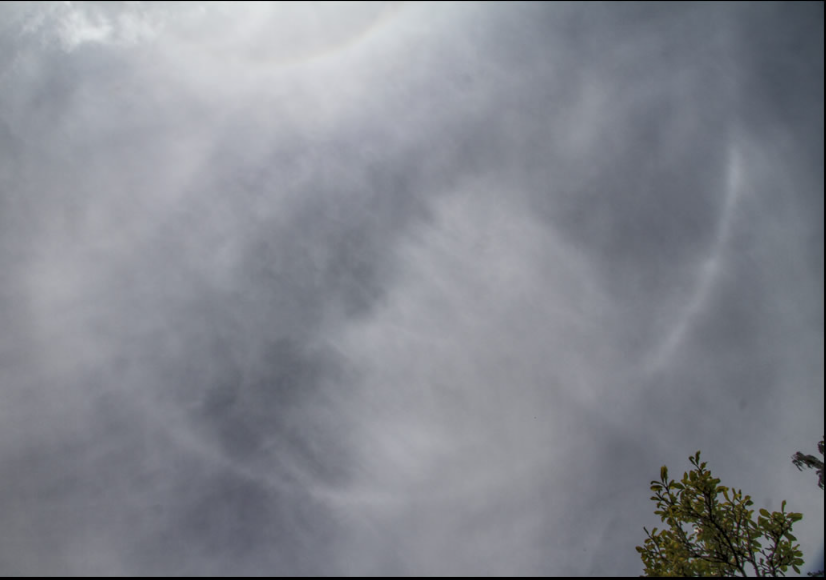
Broken cloud break up the parhelic circle and firm identification of a 120° parhelion is not possible on this frame.
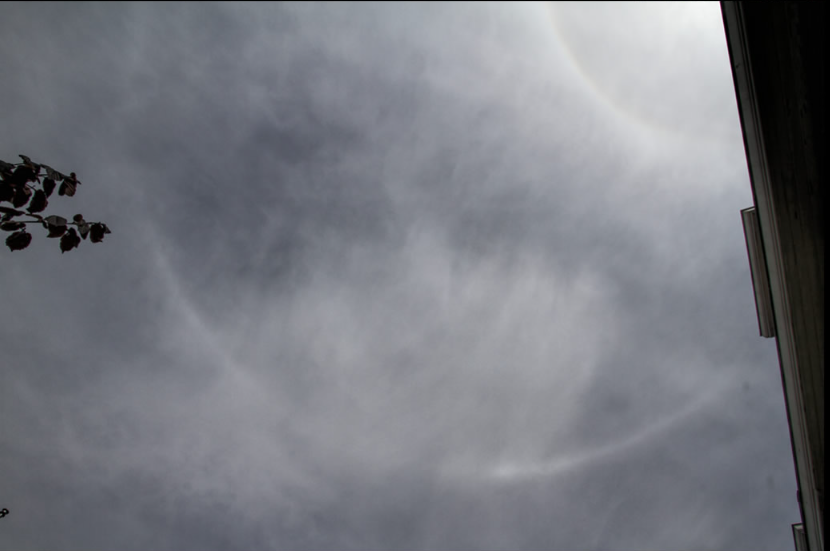
In this image we have a characteristic fading of the parhelic circle beyond the 120P - A transition from total internal reflection is the cause.
Note: this article has been automatically converted from the old site and may not appear as intended. You can find the original article here.
Reference Atmospheric Optics
If you use any of the definitions, information, or data presented on Atmospheric Optics, please copy the link or reference below to properly credit us as the reference source. Thank you!
-
<a href="https://atoptics.co.uk/blog/the-elusive-120-degree-parhelion-opod/">The Elusive 120 degree parhelion - OPOD</a>
-
"The Elusive 120 degree parhelion - OPOD". Atmospheric Optics. Accessed on April 19, 2024. https://atoptics.co.uk/blog/the-elusive-120-degree-parhelion-opod/.
-
"The Elusive 120 degree parhelion - OPOD". Atmospheric Optics, https://atoptics.co.uk/blog/the-elusive-120-degree-parhelion-opod/. Accessed 19 April, 2024
-
The Elusive 120 degree parhelion - OPOD. Atmospheric Optics. Retrieved from https://atoptics.co.uk/blog/the-elusive-120-degree-parhelion-opod/.